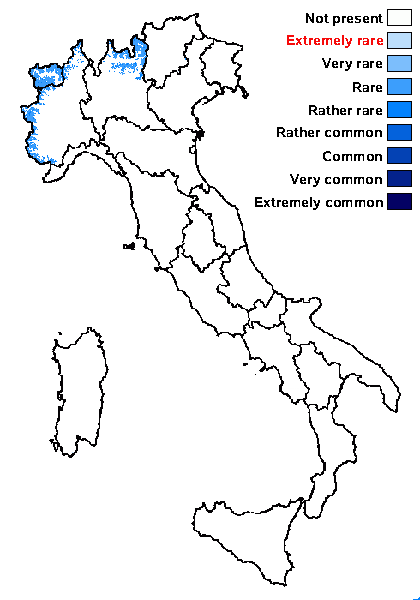Umbilicaria meizospora (Harm.) E.A. Davydov & D. Masson
Lichenologist, 54: 3, 2022. Basionym: Umbilicaria hirsuta var. meizospora Harm. - Lich. Fr., 4: 697, 1910 (1909)
Synonyms: Gyrophora hirsuta var. meizospora (Harm.) H. Olivier; Gyrophoropsis meizospora (Harm.) M. Choisy; Umbilicaria crustulosa subsp. crustulosa var. badiofusca Frey
Distribution: N - Lomb, Piem (Isocrono & al. 2004), VA (Borlandelli & al. 1996, Piervittori & Isocrono 1997, 1999).
Description: Thallus foliose-umbilicate, heteromerous, dorsiventral, monophyllous, sometimes deeply dissected and appearing polyphyllous, orbicular in outline, 3-8(-15) cm wide, 0.2-0.4 mm thick. Upper surface grey with a violet hue, darker towards margins, dull, even or slightly radially wrinkled and distinctly areolate around the umbilicus, scabrous and rimose at margin, which are often down-turned, and sometimes deeply incised. Lower surface brown-black to black, areolate-papillose towards the margins, trabeculate near the umbilicus, with numerous elongate to wart-like, dark, 1.5–2.0(–3)mm long rhizinomorphs, which usually lack around the umbilicus; thalloconidia absent. Upper cortex c. 30 µm thick; medulla white; lower cortex c. 40 µm thick. Apothecia common, omphalodisc, sessile to sunken in deep tepressions of the upper surface, black, to 4(-5) mm across, with a central sterile button, occasionally appearing subgyrose, often separated from thallus by a thin crack. Epithecium brown, 15–30 μm high; hymenium colourless, 75-100 μm high; paraphyses septate, branched, 1.5-1.8 μm thick, the apical cells sometimes slightly swollen; hypothecium pale brown, 25–50 μm high. Asci 8-spored, clavate, thick-walled, with an amyloid apical dome, Umbilicaria-type. Ascospores at first simple and hyaline, then muriform and brown (15-)18-21(-22) x (9-)11-13(-17) µm. Pycnidia numerous in the marginal zone of upper surface, immersed, bottled-shaped, with a dark brown wall and a black ostiole. Conidia bacilliform, c. (3-)4-6 x 0.8-1 µm. Photobiont chlorococcoid. Spot tests: medulla K-, C+ red, KC+ red, P-. Chemistry: medulla with crustinic acid (major), gyrophoric acid (minor), and small amounts of lecanoric and hiascic acids. Note: a species of the mountains of Southern Europe; for further details see Davydov & Masson (2022).
Growth form: Foliose, umbilicate
Substrata: rocks
Photobiont: green algae other than Trentepohlia
Reproductive strategy: mainly sexual
Poorly known taxon in need of further study
Commonnes-rarity: (info)
Alpine belt: rare
Subalpine belt: rather rare
Oromediterranean belt: absent
Montane belt: absent
Submediterranean belt: absent
Padanian area: absent
Humid submediterranean belt: absent
Humid mediterranean belt: absent
Dry mediterranean belt: absent

Predictive model
Herbarium samples
Growth form: Foliose, umbilicate
Substrata: rocks
Photobiont: green algae other than Trentepohlia
Reproductive strategy: mainly sexual
Poorly known taxon in need of further study
Commonnes-rarity: (info)
Alpine belt: rare
Subalpine belt: rather rare
Oromediterranean belt: absent
Montane belt: absent
Submediterranean belt: absent
Padanian area: absent
Humid submediterranean belt: absent
Humid mediterranean belt: absent
Dry mediterranean belt: absent

Predictive model
| Herbarium samples |
 INDEX FUNGORUM
INDEX FUNGORUM
 GBIF
GBIF
 DOLICHENS
DOLICHENS


